Apple 15-inch MacBook Pro (Late 2011) Review
by Anand Lal Shimpi on November 17, 2011 5:10 PM EST- Posted in
- Mac
- Apple
- Intel
- MacBook Pro
- Sandy Bridge
- Laptops
The early 2011 MacBook Pro is honestly Apple's best effort to date. Only using quad-core CPUs on the 15 and 17-inch models, and offering an optional Thunderbolt Display that can act as a modern day dock makes this platform, particularly the 15-inch model, the perfect candidate for users who want the power and flexibility of a desktop with the portability of a notebook. Apple gets the mobile revolution in more ways than one, and its MacBook Pro/Thunderbolt Display combo is the perfect example of that.
It's this very combination that I've been using, partially since the introduction of the Sandy Bridge MacBook Pro earlier this year (the Thunderbolt Display didn't arrive until later). I've been quite happy with the setup. With the exception of lackluster Quick Sync adoption by Apple and obviously limited GPU options, I have very few major complaints.
Late last month, Apple updated its 2011 MacBook Pro lineup - likely the first and last update before Apple adopts Ivy Bridge in Q2 next year. We got our hands on the new base 15-inch MacBook Pro configuration, which received one of the more substantial upgrades over the previous model. As this is still a fairly minor upgrade, be sure to read our original review of the platform for a deeper dive into all of the aspects of the system.
| Late 2011 MacBook Pro Lineup | |||||||
| 13-inch (low end) | 13-inch (high end) | 15-inch (low end) | 15-inch (high end) | 17-inch | |||
| Dimensions |
0.95 H x 12.78 W x 8.94 D
|
0.95 H x 14.35 W x 9.82 D
|
0.98 H x 15.47 W x 10.51 D
|
||||
| Weight |
4.5 lbs (2.04 kg)
|
5.6 lbs (2.54 kg)
|
6.6 lbs (2.99 kg)
|
||||
| CPU |
2.4 GHz dual-core Core i5
|
2.8 GHz dual-core Core i7
|
2.2 GHz quad-core Core i7
|
2.4 GHz quad-core Core i7
|
2.4 GHz quad-core Core i7
|
||
| GPU |
Intel HD 3000 Graphics
|
Intel HD 3000 + AMD Radeon HD 6750M (512MB)
|
Intel HD 3000 + AMD Radeon HD 6770M (1GB)
|
Intel HD 3000 + AMD Radeon HD 6770M (1GB)
|
|||
| RAM |
4GB 1333MHz DDR3 (8GB max)
|
||||||
| HDD |
500GB 5400 RPM
|
750GB 5400 RPM
|
500GB 5400 RPM
|
750GB 5400 RPM
|
750GB 5400 RPM
|
||
| Display Resolution |
1280x800
|
1440x900 (1680x1050 optional)
|
1920x1200
|
||||
| Ports |
Gigabit LAN, Firewire 800, Thunderbolt, 2x USB 2.0, SDHC slot, combined audio in/out jack
|
Gigabit LAN, Firewire 800, Thunderbolt, 2x USB 2.0, SDHC slot, separate audio in/out jacks
|
Gigabit LAN, Firewire 800, Thunderbolt, 3x USB 2.0, separate audio in/out jacks, ExpressCard 34 slot
|
||||
| Battery Capacity |
63.5Wh
|
77.5Wh
|
95Wh
|
||||
| Price | $1,199 | $1,499 | $1,799 | $2,199 | $2,499 | ||
Silicon Updates
The focus of Apple's late 2011 update, despite rumors to the contrary, was on the silicon inside the platform. As the Mac business is a relatively mature one, we can expect a slower pace of chassis and design upgrades compared to the iPhone/iPad businesses for example.
We'll start with the CPU, the lesser updated chip in the new MacBook Pro. System pricing hasn't changed, but CPU speeds have all gone up.
Just as before the 15-inch MacBook Pro is only available with a quad-core Intel Core i7 CPU (codename Sandy Bridge). The $1799 configuration goes from a 2.0GHz i7 to a 2.2GHz model. Be warned, this isn't the same 2.2GHz model that was available as an upgrade earlier this year though.
A quick run of Cinebench points out that the 2.2GHz i7 in our system may be a Core i7 2675QM. The original 2.2GHz option was a Core i7 2720QM. What's the difference between the two? Not a whole lot.

Max turbo is down a bit on the 2675QM. It was 3.3GHz on the 2720, but now it's 3.1GHz. The two, three and four core turbo limits are also down by 200MHz compared to what they were in early 2011. If you didn't have a 2.2GHz early 2011 15-inch MacBook Pro, these differences likely don't mean anything. If for whatever reason you're comparing to an early 2011 2.2GHz model, you'll see a slight regression in CPU bound performance.
The on-die GPU is a hair slower as well. You still get an Intel HD 3000 GPU (12 EUs) but the max turbo moves from 1.3GHz down to 1.2GHz. Or if you prefer another way of looking at it, the 2675QM is the same as the 2670QM, except the GPU is able to clock 100MHz higher (1.2GHz vs. 1.1GHz).
| Apple 15-inch Late 2011 MacBook Pro CPU Comparison | |||||
| 2.2GHz quad-core | 2.4GHz quad-core | 2.5GHz quad-core | |||
| Intel Model | Core i7-2675QM | Intel Core i7-2760QM | Intel Core i7-2860QM | ||
| Base Clock Speed | 2.2GHz | 2.4GHz | 2.4GHz | ||
| Max SC Turbo | 3.1GHz | 3.5GHz | 3.6GHz | ||
| Max DC Turbo | 3.0GHz | 3.4GHz | 3.5GHz | ||
| Max QC Turbo | 2.8GHz | 3.2GHz | 3.3GHz | ||
| L3 Cache | 6MB | 6MB | 8MB | ||
| AES-NI | Yes | Yes | Yes | ||
| VT-x | Yes | Yes | Yes | ||
| VT-d | No | Yes | Yes | ||
| TDP | 45W | 45W | 45W | ||
The upgraded 15-inch configuration comes with an all new Sandy Bridge SKU: the Core i7 2760QM running at 2.4GHz. Unlike the old 2.3GHz part, the 2760QM still only has a 6MB L3 cache. You do get higher base and turbo speeds. There's also a new 2.5GHz quad-core option that can run at up to 3.6GHz with a single core active. That's an absolutely insane frequency for a notebook. Notebook-as-a-desktop users will appreciate the flexibility here.
All of the new CPUs support AES-NI, although once again Apple is the victim of Intel's silly segmentation. The entry level 2.2GHz part does not support VT-d (Virtualization Technology for Directed I/O), which allows virtual machines to have direct access to I/O devices (including PCIe GPUs). I'm not sure if any current virtualization software for OS X supports VT-d, but the absence of the feature is important to note nonetheless. The rest of the CPU lineup supports VT-d.

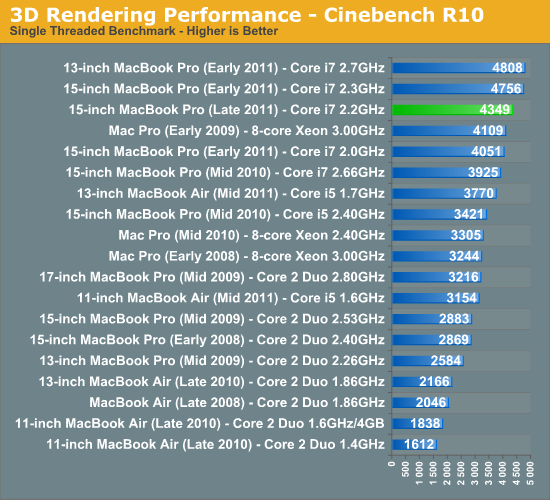
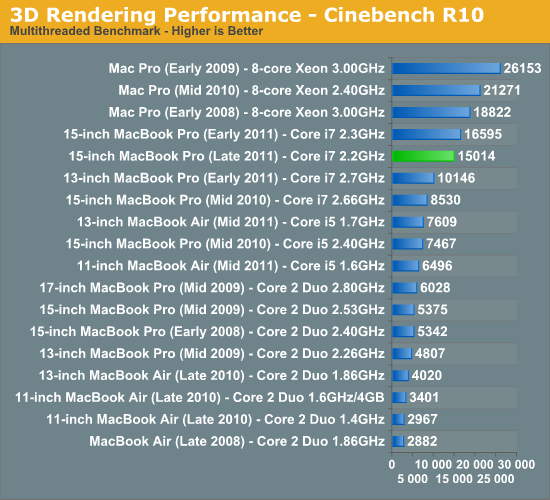
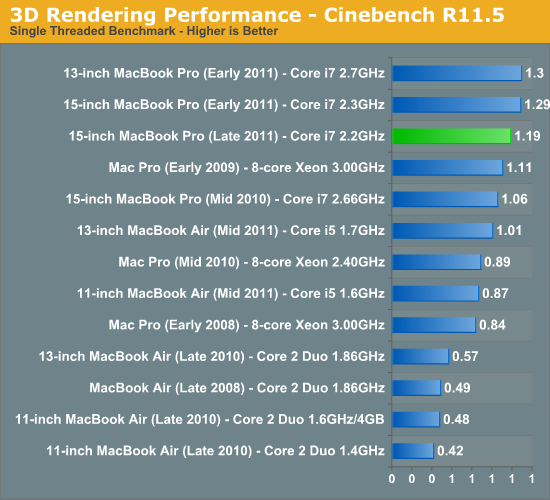
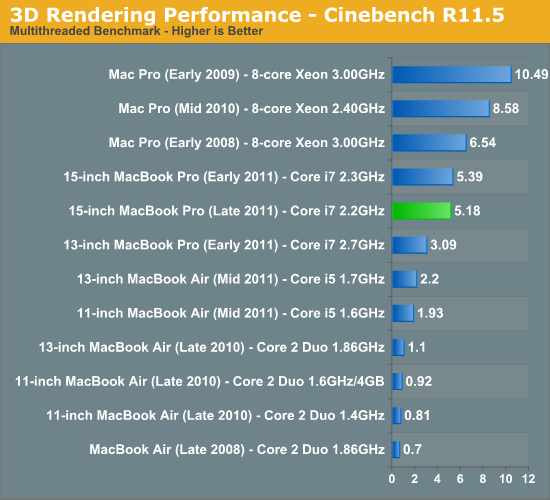
Battery Life
TDPs haven't changed, nor has the MacBook Pro's battery capacity, so overall battery life should (and does) remain relatively unchanged from the early 2011 models. Worst case scenario you can expect around 2.5 hours of battery life under load. With moderate load expect 4 - 5 hours of use on a single charge. And under a very light load you can easily exceed 7 hours.
I ran our normal battery life suite, however Lion has made some of the numbers a little less comparable than I would've liked. The lighter use cases (e.g. our web browsing tests) see a drop compared to our older Snow Leopard results. Under full load the new platform, even while running Lion, actually did a bit better than its predecessor. All in all I'd say the new MacBook Pro is pretty consistent with its predecessor - Lion just threw a wrench in a lot of our battery life comparisons so we'll be starting over from scratch in building our new database.
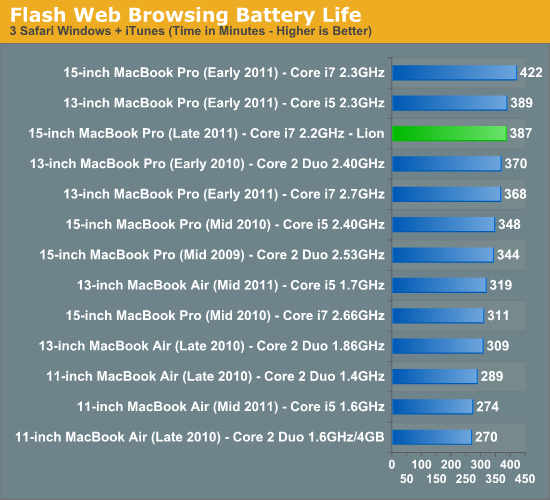
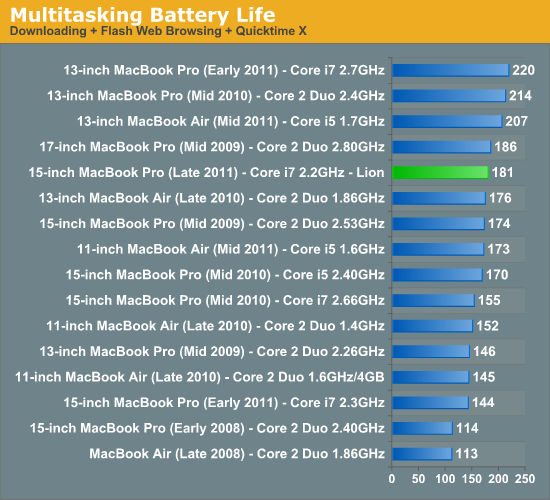


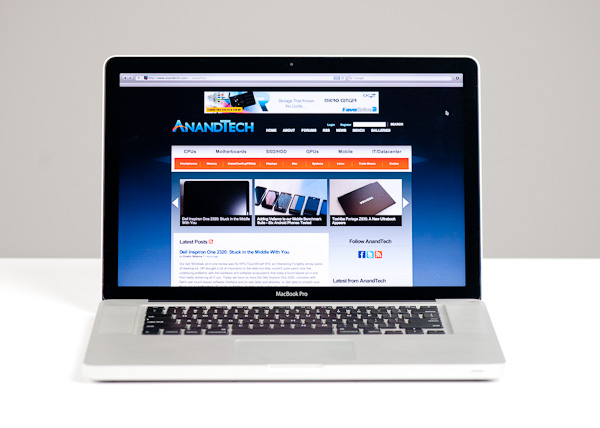
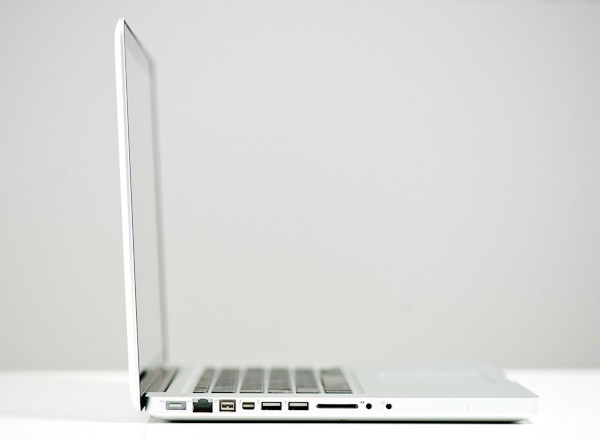
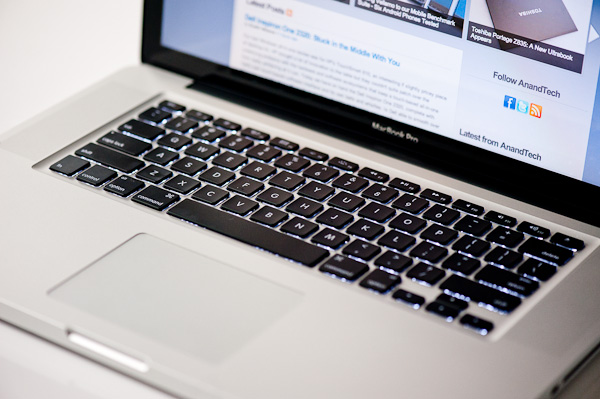








101 Comments
View All Comments
Omid.M - Monday, November 21, 2011 - link
Is 22W TDP? I thought I saw 35W or the same as current platform, at least on some chart a few months back.And wouldn't the power/heat savings of a 22W TDP be negated by going to a slimmer design, if that's the next move for the rumored model update in Summer 2012?
Anand,
Good thoughts about the optical drive not being the sole factor in making the chassis thinner.
Correction (?)
Given that there are no reasonable performing HDDs in a smaller form factor, one would assume that if and when Apple removes the optical drive from the MacBook Pro, it will also remove the hard drive.
--it will also move way from the 2.5" form factor HDDs
Right?
@moids
Omid.M - Monday, November 21, 2011 - link
What do you recommend for photo work?Quad core MBP 15 + ACD or iMac 27 (quad core) ?
@moids
KoolAidMan1 - Monday, November 21, 2011 - link
Here is a benchmark with recent machines, but unfortunately they are only video apps: http://barefeats.com/macs11_01.htmlHere are Aperture benchmarks from August, so tweaks your expectations accordingly: http://barefeats.com/aper313.html
Performance is excellent both ways, so ask yourself what your usage is. Does your powerhouse workstation need to be portable? Do you need a laptop? If so, get the MBP+TB display. Otherwise save your money and get an iMac instead, much much cheaper than the laptop+TB display.
spamcops - Tuesday, November 22, 2011 - link
I just registered because of this article suggesting Intel SSD 510 disk with this macbook pro model. Actually I was testing this disk with Macbook Pro 13' early 2011 and its horrible. There are lockups in IO intensive reads (for example spotlight indexing, lock lasting like 30s - basicaly you sea only beachball). Result are messages about corrupted filesystem in system.log. Probably its same issue with late 2011 model. EFI firmware update 2.3 didnt helped.It looks like there is issue with sata cable or something with macbook pro and all 6gbit SSD disks (not only intel).
Then I tested Intel SSD 320 model and it was fine - very good performance without problems, even if negotiated speed was only 3Gbit (SATA2).
Cheers
Daniel
MadMacMan - Thursday, November 24, 2011 - link
Are you talking about the optical drive bay or the main HDD bay? SATA III 6Gbps works just fine in the main hard drive bay and on 13" MBP's (as opposed to 15" and 17" models, both Early and Late 2011), you can even RAID 2 SATA III SSD's for sequential speeds north of 900MB/s. I'm not sure why you have the experience that you do, but that's not the case on a widespread basis. I've tried this on one Early-2011 15" MBP and two Late-2011 17" MBP's.CalaverasGrande - Tuesday, November 22, 2011 - link
still maxes at 8gb! I know that may seem like plenty of ram, but those of us using VM's can easily exploit all of the ram that is available. Not to mention that many Mac users will hang on to their Macs for 4-5 years. I am confident 16gb will be the new 4gb by then!MadMacMan - Saturday, December 10, 2011 - link
Agreed. I have 8GB in my Late-2011 MBP and I'm using it all and it's just about the perfect amount for Safari and Chrome and 40+ tabs open at the same time between the two. So it'll happen that I have Flash plug-in's running on both and Netflix uses Silverlight, and while I do realize that I could cut that in half with a little bit of discipline, I simply don't care to. I didn't buy a Quad Core i7 system to save on...anything really. I'm still peeved that the optical drive bay won't work well with my 2nd of two SATA III SSD's in RAID mode, as I had my previous Mac configured.Having said that, there are 8GB modules available from OWC for quite a steep fee, but it's technically not correct that the MacBook Pro is limited to 8GB of RAM. If you get two of those babies, you'll have a full 16GB, which I had at one time but in an iMac, so it was 4x4GB and tons cheaper, of course. With that setup, I was able to run a VM with Windows 7 in it, so dedicating 8GB to the VM and having both OS X and Windows running on all cylinders and totally stably was not a problem.
UPDATE: Wait a minute. Prices have plummeted to "only" $395 for the full 16GB! Wow! So if you have 2x4GB, you can get one 8GB chip for $200, sell the one 4GB stick to offset the cost and you'll end up with 12GB for the difference. Hmmm....lol
flomt - Saturday, December 24, 2011 - link
Does Apple ship you a product to test, knowing who you are, or do you go to a store and buy one?I have a macbook pro 13 mid 2010 and out of the box only got half the battery life you seen to have.
After visiting with Apple about my "poor" battery life, they said I was normal.
Visiting with some friends, nobody came come close to your battery times.
Why the big differences?
bob33 - Saturday, March 24, 2012 - link
So, as gradjoh mentioned, in layman's terms is the "early 2011" 2.3 GHz 4Gb RAM model better than the "late 2011" 2.4 GHz 4Gb RAM model, in terms of speed/performance, etc.?Thanks
MiddletonBanks - Tuesday, April 17, 2012 - link
If you are looking for a macbook to run memory hungry games or to do a lot of photo editing and won't be looking to carry it about everyday then the macbook pro 15 is the one for you. You can buy it here http://www.middletonbanks.com/acatalog/Apple_MacBo... for only £1,240 including VAT and delivery.